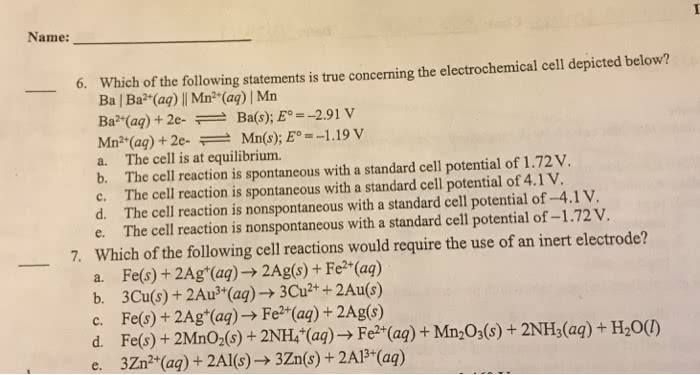electrochemical cells! Please help me!
1.
Given the two half-cells: [reduction potentials from CRC 71st ed, p 8-17]
Fe2+ + 2e- --> Fe Eo = -0.447 V
Cu2+ + 2e- --> Cu Eo = + 0.342 V
a.) Given the two possible reactions:
1.) Fe2+ + Cu --> Fe + Cu2+ or
2.) Cu2+ + Fe --> Cu + Fe2+
which would be the spontaneous reaction (enter 1 or 2).
b.) If the two half-cells were joined, what is the Eo for the reaction which will occur spontaneously?
c.) What would be the cell potential for a copper-iron electrochemical cell in which [Cu2+] = 0.100 M and [Fe2+] = 0.100 M?
d.) What would be the cell potential for a copper-iron electrochemical cell in which [Cu2+] = 0.002 M and [Fe2+] = 0.198 M?
2. n the copper-iron electrochemical cell above, which metal electrode (Fe or Cu) is the anode?
A. Fe
B. neither
C. Cu
D. both
3. In which direction will the electrons flow during this spontaneous reaction?
A. From Fe to Cu
B. no electron flow will occur
C. From Cu to Fe
4.
Given the two half-cells:
Pb2+ + 2 e- --> Pb Eo = -0.1262 V
Sn2+ + 2 e- --> Sn Eo = -0.1375 V
As an electrochemical cell discharges, the concentrations of the various species change. If you started with 100.0 mL of 0.1000 M Pb2+ in the lead half cell and 100.0 mL of 0.1000 M Sn2+ in the tin half cell, at what concentration of each would the cell have a cell potential of zero?
[Sn2+] = ?M = [Pb2+] = ?M
electrochemical cells! Please help me!
1.
Given the two half-cells: [reduction potentials from CRC 71st ed, p 8-17]
Fe2+ + 2e- --> Fe Eo = -0.447 V
Cu2+ + 2e- --> Cu Eo = + 0.342 V
a.) Given the two possible reactions:
1.) Fe2+ + Cu --> Fe + Cu2+ or
2.) Cu2+ + Fe --> Cu + Fe2+
which would be the spontaneous reaction (enter 1 or 2).
b.) If the two half-cells were joined, what is the Eo for the reaction which will occur spontaneously?
c.) What would be the cell potential for a copper-iron electrochemical cell in which [Cu2+] = 0.100 M and [Fe2+] = 0.100 M?
d.) What would be the cell potential for a copper-iron electrochemical cell in which [Cu2+] = 0.002 M and [Fe2+] = 0.198 M?
2. n the copper-iron electrochemical cell above, which metal electrode (Fe or Cu) is the anode?
A. Fe
B. neither
C. Cu
D. both
3. In which direction will the electrons flow during this spontaneous reaction?
A. From Fe to Cu
B. no electron flow will occur
C. From Cu to Fe
4.
Given the two half-cells:
Pb2+ + 2 e- --> Pb Eo = -0.1262 V
Sn2+ + 2 e- --> Sn Eo = -0.1375 V
As an electrochemical cell discharges, the concentrations of the various species change. If you started with 100.0 mL of 0.1000 M Pb2+ in the lead half cell and 100.0 mL of 0.1000 M Sn2+ in the tin half cell, at what concentration of each would the cell have a cell potential of zero?
[Sn2+] = ?M = [Pb2+] = ?M

